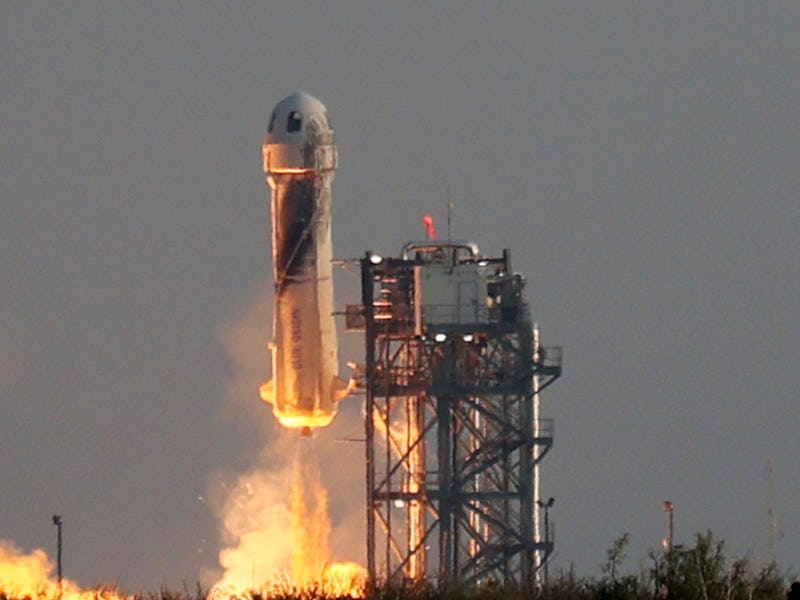Blue Origin: How Jeff Bezos plans to open up space after crewed flight
Jeff Bezos' spaceflight firm Blue Origin has done it, and it's only just getting started in space tourism.

Jeff Bezos has gone to space — and now he wants to open it up to more people (who can pony up for the price, at least).
Blue Origin has big plans to expand space tourism after its successful flight — and it could use what it learns to power its more ambitious goals. Over time it could use what it’s learned to develop new rockets, ones that can launch satellites and other cargo into orbit.
On Tuesday at 9:12 a.m. Eastern time, Bezos’ firm Blue Origin launched the New Shepard rocket from its facility in West Texas. Onboard were Bezos, his brother Mark, 82-year-old aviator Wally Funk, and 18-year-old student Oliver Daeman. The latter two passengers were the oldest and youngest people to ever go to space, respectively.
Over the course of just under 11 minutes, the rocket and booster reached a maximum altitude of around 65 miles, just past the 62-mile Karman line typically described as the border between Earth’s atmosphere and space. The vehicle reached a maximum ascent velocity of 2,233 mph before slowing down, giving the passengers a chance to experience weightlessness over the space of around three minutes.
Want to find out more about the emergent new space race and competitors like SpaceX and Blue Origin? Subscribe to MUSK READS+ for exclusive interviews and analysis about spaceflight, electric cars, and more.
While the four passengers recover from their big trip, other jaunts to space are on the horizon.
Blue Origin: space tourism on the way
During the live feed, the firm claimed it was open for more space tourists now. Interested parties can write to astronauts@blueorigin.com to express their interest. Customers can also fill out the website form. Pricing, unfortunately, has yet to be revealed.
The crew’s excited faces after the trip suggest it was a lot of fun — but this fun will likely be restricted to the mega-rich for now. Blue Origin’s first seat on a crewed flight sold at auction for an eye-popping $28 million.
Blue Origin's first crewed flight passengers leaving the capsule.
Meanwhile, back on Earth, climate change is making heatwaves more deadly.
New Shepard, which burns liquid hydrogen and oxygen as its fuel, is one of the cleaner rockets. Darin Toohey, an atmospheric scientist at the University of Colorado, Boulder, told LiveScience that the main emissions “will be water and some minor combustion products, and virtually no CO2.”
When it comes to other harmful particulates associated with rocket launches, like soot and aluminum oxide, Toohey said it “might be among the cleanest of the fuels.”
But small particulates or otherwise, a several-minute jaunt to space for the minted seems an odd use of the planet’s resources. It’s perhaps in the next phase of expansion where Blue Origin will make a broader contribution.
Blue Origin: paving the way for New Glenn
The successful mission doesn’t only pave the way for further suborbital crewed missions. It also helps develop Blue Origin’s bigger and more powerful rocket called New Glenn, which could send people even further into space.
The firm describes the New Shepard rocket as effectively the second stage of New Glenn, a much larger rocket under development designed to send crew and cargo to orbit.
The two-stage New Glenn rocket uses a modified version of New Shepard’s BE-3 engine on its second stage. Where New Shepard uses a single BE-3 engine, New Glenn’s second stage uses two BE-3U engines.
“There’s quite a bit of technology transfer from New Shepard to New Glenn,” Jarett Jones, head of the New Glenn program, said during the livestream of Tuesday’s launch.
The rocket will take off from Launch Complex 36 at Cape Canaveral in Florida. Similar to SpaceX’s Falcon 9, Blue Origin plans to land the New Glenn first stage booster on a moving ship at sea. Blue Origin aims for each booster to fly a minimum of 25 times.
Oh, and it’s big. Blue Origin boasts that the fairing has twice the usable volume of any existing launch vehicle. It towers over SpaceX’s existing Falcon 9 and Falcon Heavy rockets to reach nearly 100 meters (nearly 330 feet) high.
Blue Origin's comparison of New Glenn with other rockets.
The rocket can lift up to 45 metric tons to low-Earth orbit at a time, which means companies and government agencies can build out satellite constellations that benefit people on Earth. It could mean better weather tracking, satellite navigation, emergency responses, and more.
Some of this rapid expansion into low-Earth orbit is controversial. Starlink, SpaceX’s internet connectivity constellation, has come under fire with astronomers for disrupting their work. Experts have called for better regulation of Earth’s orbit.
But as Bezos summarized in an interview with CNN, the first crewed mission is about “building a road to space for the next generations to do amazing things there, and those amazing things will solve problems here on Earth.”
SUBSCRIBE TO MUSK READS+, A PREMIUM NEWSLETTER COVERing THE WORLDS OF ELON MUSK, SPACEX, TESLA, AND EVERYTHING BETWEEN.